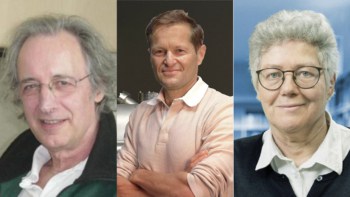
A new type of microscope that can detect terahertz (THz) electromagnetic waves with unprecedented accuracy could be used to reconstruct detailed images that are inaccessible through standard methods. The device, which was developed by researchers at the University of Sussex in the UK, relies on a technique called nonlinear ghost imaging and could find applications in areas such as the life sciences, quality control in manufacturing and airport security.
THz radiation lies between microwaves and infrared radiation on the electromagnetic spectrum. Like X-rays, it easily passes through materials that are opaque to visible light, but its lower energy means that it does so without damaging living tissues. It is thus safe to use on even the most fragile biological samples. Images produced using THz radiation are also hyperspectral, meaning that each pixel in the image contains the electromagnetic signature of the corresponding area of the imaged object. This property enables researchers to visualize the molecular composition of objects and so distinguish between different materials.
Until now, however, microscopes capable of capturing images that preserve the fine details revealed by THz waves were not considered possible. This, explains project leader Marco Peccianti, is because the details you want to see are typically much smaller than the THz wavelength, and the more you focus on them, the more their electromagnetic signature is altered. “The main challenge in THz cameras today is not just about collecting an image but about preserving the object’s spectral fingerprint, which can easily be corrupted by the technique employed,” says Peccianti, who leads the Emergent Photonics (EPic) laboratory at Sussex.
Passing visible light patterns through a thin nonlinear crystal
To overcome this problem, Peccianti and colleagues developed a camera based on visible-light patterns generated by a laser. These patterns change in time, and the researchers pass them through a thin nonlinear crystal that converts them into patterns of THz light. The THz patterns are then projected onto the object being imaged, which – as in an optical microscope – is located very close to the camera.
When this series of known THz light patterns shines onto the object, a single-pixel field detector measures the intensity of the resulting scattered light. By processing multiple signals of varying light intensity from the detector, the researchers are able to reconstruct an image of the object without actually imaging the light scattered directly from it – a computational technique known as ghost imaging.
“The way our technique images the object is based on the fact that each light pattern is actually a THz pulse in time (with an associated shape in space),” Peccianti tells Physics World. “Just as in ultrasound imaging, we receive a wave that contains full information about the object. Our technique captures all the object information and ‘de-shuffles’ its content to produce a hyperspectral image with hitherto inaccessible fidelity.”

Ghost images obtained using relativistic electrons
Potential applications for the camera include electromagnetic biopsy of skin tumours and quality control in manufacturing. It could also be used to perform chemical analyses of samples in a non-destructive way, such as in airport security, Peccianti says.
The researchers, who report their work in Optica, say they are now applying machine-learning techniques to speed up the image reconstruction process in their system.



